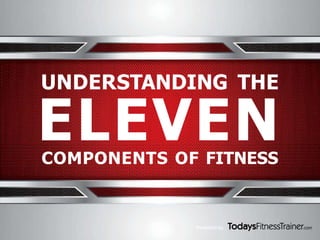tftcomponentsoffitness022314-140223115753-phpapp01.pptx
- 1. UNDERSTANDING THE Presented by COMPONENTS OF FITNESS
- 2. THE ELEVEN COMPONENTS OF FITNESS FITNESS Presented by is defined as a condition in which an individual has enough energy to avoid fatigue and enjoy life.
- 3. THE ELEVEN COMPONENTS OF FITNESS PHYSICAL FITNESS Presented by is divided into five HEALTH-RELATED and six SKILL-RELATED components. CARDIORESPIRATORY FITNESS MUSCULAR STRENGTH MUSCULAR ENDURANCE FLEXIBILITY BODY COMPOSITION AGILITY BALANCE POWER SPEED COORDINATION REACTION TIME
- 4. THE ELEVEN COMPONENTS OF FITNESS HEALTH-RELATED COMPONENTS Presented by
- 5. THE ELEVEN COMPONENTS OF FITNESS CARDIORESPIRATORY FITNESS Cardiorespiratory fitness is the ability of the circulatory system (which consists of the heart and blood vessels) to supply oxygen to working muscles during exercise. Examples of cardiorespiratory fitness activities include: ŌĆó Walking ŌĆó Swimming ŌĆó Cycling ŌĆó Running ŌĆó Rowing ŌĆó Cross-country skiing Presented by
- 6. THE ELEVEN COMPONENTS OF FITNESS MUSCULAR STRENGTH Muscular strength refers to the maximum amount of force a muscle can produce in a single contraction. Examples of muscular strength exercises include: ŌĆó Bench Press ŌĆó Bent Over Row ŌĆó Deadlift ŌĆó Squat ŌĆó Lunge ŌĆó Bicep Curl ŌĆó Tricep Dip Presented by
- 7. THE ELEVEN COMPONENTS OF FITNESS MUSCULAR ENDURANCE Muscular endurance refers to the ability of a muscle to continue contractions for an extended period of time without fatigue. Examples of muscular endurance exercises include: ŌĆó Push-Up (max. repetitions) ŌĆó Sit-Up (max. repetitions) ŌĆó Pull-Up (max. repetitions) ŌĆó Plank Hold (max. time) ŌĆó Walking Lunges (max. time) Presented by
- 8. THE ELEVEN COMPONENTS OF FITNESS FLEXIBILITY Presented by Flexibility refers to the ability to move a body part through a full range of motion (ROM) at a joint. Examples of flexibility exercises include: ŌĆó Static stretches (holding a stretch in one position for a duration of time) ŌĆó Dynamic stretches (quickly moving muscles and joints through a full range of motion) ŌĆó PNF stretches (shortening contraction of the opposing muscle to place the target muscle in stretch)
- 9. THE ELEVEN COMPONENTS OF FITNESS BODY COMPOSITION Presented by Body composition refers to the ratio of body fat to lean body mass (including bone, muscle, connective tissue, and water). Examples of ways to improve body composition include: ŌĆó Cardiorespiratory exercises (i.e., walking, cycling, running) ŌĆó Muscular strength exercises (i.e., bench press, deadlift, squats, bicep curls) ŌĆó Muscular endurance exercises (i.e., push-ups, pull-ups, sit-ups)
- 10. THE ELEVEN COMPONENTS OF FITNESS SKILL-RELATED COMPONENTS Presented by
- 11. THE ELEVEN COMPONENTS OF FITNESS AGILITY Presented by Agility is the ability of the body to change direction quickly and effectively while under control. It requires the integration of isolated movement skills using a combination of balance, coordination, speed, reflexes, strength, and endurance. Examples of activities that require agility include: ŌĆó Football ŌĆó Soccer ŌĆó Tennis ŌĆó Volleyball ŌĆó Basketball ŌĆó Most competitive sports
- 12. THE ELEVEN COMPONENTS OF FITNESS BALANCE Presented by Balance is the ability to maintain an upright posture while in a stationary position or while moving. Examples of activities that challenge balance include: ŌĆó Yoga ŌĆó Pilates ŌĆó Gymnastics ŌĆó Single leg exercises ŌĆó Bosu ball exercises ŌĆó Stability ball exercises
- 13. THE ELEVEN COMPONENTS OF FITNESS POWER Presented by Power is the ability to do strength work at an explosive pace (it is defined as the amount of work performed per unit of time). Examples of activities that require power include: ŌĆó Olympic lifts (i.e., clean & jerk, snatch) ŌĆó Plyometrics (i.e., box jumps, depth jumps, clap push-ups) ŌĆó Baseball ŌĆó Boxing ŌĆó Golf ŌĆó Volleyball ŌĆó Track and Field (i.e., high jump, long jump, pole vault, javelin)
- 14. THE ELEVEN COMPONENTS OF FITNESS SPEED Presented by Speed is the ability to move quickly from one point to another. Examples of activities that require speed include: ŌĆó Sprinting (i.e., 100 meter, 200 meter, 400 meter) ŌĆó Speed skating (i.e., 500 meter, 1000 meter, 5000 meter) ŌĆó Swimming (i.e., front crawl, butterfly, back stroke) ŌĆó Nordic Skiing (i.e., classic or skating)
- 15. THE ELEVEN COMPONENTS OF FITNESS COORDINATION Presented by Coordination is the integration of hand and/or foot movements with the input of the senses (i.e., what we see, hear, and feel). Examples of activities that require coordination include: ŌĆó CrossFit ŌĆó Group fitness classes (i.e., Zumba, Body Pump, Body Attack, Bootcamp) ŌĆó Baseball ŌĆó Basketball ŌĆó Golf ŌĆó Jumping rope ŌĆó Martial arts (i.e., karate, judo, taekwondo) ŌĆó Skiing/Snowboarding
- 16. THE ELEVEN COMPONENTS OF FITNESS REACTION TIME Presented by Reaction time is the amount of time it takes to react to a stimulus (i.e., starting gun, moving object, movement of an opponent). Examples of activities that require a fast reaction time include: ŌĆó Racquet sports (i.e., tennis, squash, racquetball, badminton) ŌĆó Baseball and cricket ŌĆó Sprinting, speed skating, and swimming ŌĆó Martial arts (i.e., karate, judo, taekwondo) ŌĆó Most competitive individual and team sports
- 17. THE ELEVEN COMPONENTS OF FITNESS THANK YOU! Presented by For more information visit www.todaysfitnesstrainer.com
















